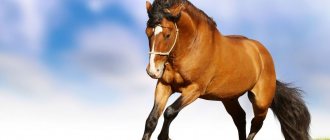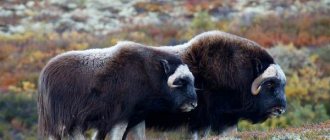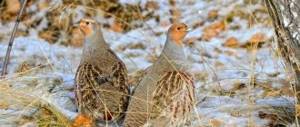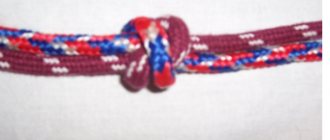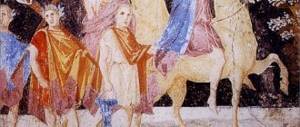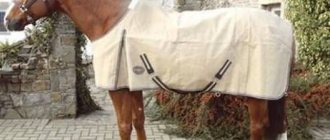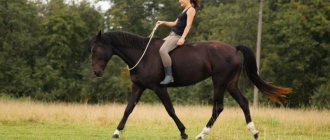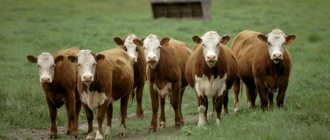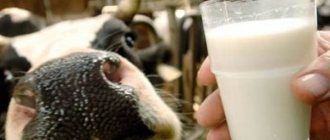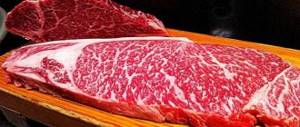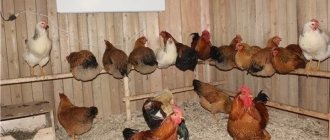For thousands of years, people have determined the age of a horse by its teeth. The error of this method is minimal. With age, an animal's teeth almost wear out, and sometimes disappear completely, becoming almost invisible. The condition of a horse's teeth directly depends on the structure of the jaw, bite, quality of feed, and also on the breed. Purebred horses are endowed with harder bone mass, unlike their simpler counterparts. The skeleton of purebred individuals is stronger, which means the jaw is the same.
Uneven wear of a horse's teeth can occur due to improper alignment of the upper and lower jaw. Their abrasion is also influenced by the way the animal feeds. Two stallions of the same age can have very different dental conditions. If the first one is fed only in the stable with cleaned hay and pure oats, his teeth will be better preserved. And in the second, which obtains most of the food itself in free grazing, the enamel of the chewing organs will be damaged by particles of sand that are present on the grass.
The structure of a horse's teeth
Inside the mouth there are mucous tissues with vessels and nerves woven into it. Dentin is filled with nutrients through the blood vessels of the pulp. The hidden part of the tooth, located in the gum, is called the root, and the visible part is called the corolla. A canal runs through its entire cavity, from the root to the corolla.
As the enamel wears away, it is gradually pressed inward, taking the shape of the bottom of the bottle. If you saw off part of such a tooth, you will see gray bone matter and white enamel. The deepest “cup” appears on the upper incisors.
The bottom of such a recess is covered with cement, which, upon completion of abrasion of the cup, is surrounded by an enamel layer. Together they form the trace of the calyx. A horse's teeth are covered with enamel on the outside. This is the hardest tissue of the ungulate body. Their strength depends on the mineral composition. The root of the tooth is cement, which also makes up the entire crown and cup.
As wear occurs, five layers of the tooth appear in turn:
- cement internal;
- cement exterior;
- adjacent to the internal cement, enamel;
- adjacent to the outer one, enamel;
- dentine.
Microstructure of equine teeth
The horse's teeth sit in special jaw sockets - alveoli. Above the alveoli rises a crown, the shape of which depends on the type of tooth: wedge-shaped - for incisors; with tubercles - in molars; cone-shaped - at the fangs.
The crown surfaces are divided into:
- labial (vestibular);
- lingual;
- medial;
- distal;
- occlusive.
The root of the tooth is located inside the alveolus. Although horse teeth usually have a long crown, with age it gradually wears down and begins to protrude significantly from the socket. Between the horse and the crown is the so-called neck.
The inside of the tooth cavity is filled with pulp, which is soft tissue. The pulp consists of connective tissue, nerves and blood vessels.
It is the source of all nutrients necessary for other dental tissues.
The top of the tooth cavity is covered with dentin, which occupies almost 80 percent of the entire mass of this formation.
Dentin consists of specially arranged odontoblast cells and contains many minerals. This makes it much stronger than ordinary bone tissue. The intercellular substance of dentin is organic fibers that are located in tangential and radial directions.
The mineral composition of dental tissue directly determines their hardness and resistance to abrasion, as well as other chemical and physical influences. Additionally, the tooth is reinforced with a special covering layer – enamel, which is the hardest tissue of the horse’s body. The mineral content in it is more than 90 percent.
The color of the enamel can be milky or white. A yellowish tint is also allowed. The thickness of the enamel layer is not the same everywhere: on the tongue side it is the thinnest (here the impact on the crown is weakest), and on the rubbing surface this layer reaches the pulp itself, protecting it from external influences. Due to this unevenness, folds appear on the rubbing surface of horse teeth, making it easier for the animal to grind plant and other food. Over time, the enamel layer and cement begin to wear off, and the position of these folds changes. Experienced horse breeders use this fact when determining the age of an animal.
The part of the horse tooth that is located in the alveolus is covered with cement.
Its strength is less than that of enamel. The color of cement is white-yellow. As the top layer of enamel wears away, the cement gradually comes out, especially in older horses. You can see a lot of it on the edges.
More on the topic: Reasons for such a phenomenon as driven horses
Incisors
There are six incisors in the upper and lower rows, among which are the hooks, middle teeth and edges. In the horse, like in all animals, they change from dairy to permanent. The latter are distinguished by their larger size and yellow color.
The incisors of a young horse form a semicircle. With age, they gradually take on a flat shape. As they age, they straighten, and at the same time, the position of the horse’s upper and lower teeth to each other changes. The incisors of young horses are adjacent to one another, like pincers. But as they grow older, the angle between them becomes sharper.
The order of changing teeth and their types
Milk teeth in equids appear at the age of 1-2 weeks (sometimes foals are already born with teeth), and are replaced by molars at the age of 2 to 5 years.
Baby teeth:
- bright snow-white color,
- have a wide spatulate crown,
- noticeable neck,
- small size,
- almost no cement
- homogeneous surface, very small grooves.
A horse's teeth are in the growth stage all his life, and as they grow, they wear out, like all herbivores. Therefore, the age of horses is determined by their teeth. In order for animals to have normal teeth, they need to be fed as close as possible to how a horse feeds in the wild. She should have plenty of hard food: hay and straw. And horses should chew these roughages for as long as possible throughout the day. A horse usually eats whenever it is not sleeping, and it spends only 4 hours a day sleeping. If only compound feed is given, then the horse’s caloric needs are, of course, satisfied, but the teeth do not receive the load that they should receive in the natural environment.
Important! Permanent teeth are yellowish, larger in size and have a rectangular shape, while baby teeth are bluish-white, wedge-shaped with a pronounced “neck”.
Primary and permanent incisors
Table 1. When different types of teeth change
| Type of teeth | When they change |
| Incisors – anterior | The first ones to grow. At 2.5 years, the milk ones are replaced by permanent ones. The two teeth in the center are called hooks. They capture the food and cut it. They are also used for attack and defense. If the animal is young, its jaws look like pincers; with age they move back. There are 12 incisors in total, 6 each on top and bottom. |
| Premolars - middle | Premolars erupt second and are subsequently replaced. Middle teeth are replaced at 3.5 years. They mainly grind food. There are 6 premolars in total. |
| Margins (molars) – outer teeth | They appear last. At 6-9 months. At 4.5 years, the top and bottom triplets are replaced by permanent ones. Molars immediately grow into molars. Their function is to grind food. There are 12 of them in total. |
| Fangs | They are found exclusively in horses, shown at the age of 5 years, 2 each on the upper and lower jaws. They first appear in the vicinity of the incisors and are drawn towards them, but then gradually turn in the other direction. In exceptional cases, they also appear in mares, but they are poorly developed and quickly fall out. |
Video - How to saw a horse's teeth
Fangs
One of the gender differences in horses is the presence of fangs. Only stallions have them: two on the upper jaw and two on the lower. Sometimes, in exceptional cases, mares grow weakly defined fangs. Their condition does not help determine the age of the horse. They begin to erupt in the fourth or fifth year. However, in some individuals their emergence can occur at two years, and in others at eight years.
The stallion's newly emerging fangs are sharp. On the inside, towards the tongue, they have a rough surface. Their front side is smooth. At the beginning of growth, the canines are placed closer to the incisors. Gradually, as the animal grows, they change their position, turning away from the front ones. Their surface becomes smooth from the inside. The canines of the upper jaw are often worn down to the base, becoming almost invisible, and the lower ones grow long, but are no longer so sharp.
Experts know how to identify a horse by its teeth - older ungulates, as a rule, have stone on their fangs.
Establishing the age of a horse's teeth
In the modern world, when buying a horse, we rely more on documents, but before, the age of a horse literally up to a year, as well as its health, was determined solely by its teeth.
Throughout its life, the horse's teeth are gradually worn away by grinding food; normally, this occurs evenly. At birth, foals have depressions called “cups” on the surface of the incisor.
Table 3. How to determine the age of a horse by its teeth
| Horse age | Sign |
| 1 year | The recesses of the hooks disappear |
| 1.5 | Are worn down on the teeth in the middle |
| 2 | Disappear on the edges |
| 5 | Milk teeth are replaced by molars |
| 6 | The cups of the lower hooks are worn out |
| 7 | Cups disappear in the middle at the bottom |
| 8 | No cups on the bottom edges |
| 9 | The cups of the upper hooks are worn out. “Seals” form on the upper edges |
| 10 | The cups of the middle teeth disappear from above |
| 11 | No cups on the upper edges |
| From 12 to 16-18 years old | The surface of the tooth changes its shape from oval to round. The “jams” disappear. Sometimes after 15 years “secondary jams” may appear |
| 18-24 | The chewing surface will become triangular |
| From 24 | Erases back to oval |
Also, the age of a horse is indicated by “root stars”. At 7-9 years old, on the bottom of the teeth they look like narrow stripes of yellow-brown color, at 10-14 years old they look like oval stripes, and at 15 they will become round in shape.
If you do not set yourself the task of knowing the age of a horse accurately up to a year, and you just need to find out whether the horse is young or old, then you can slightly lift the horse’s upper lip and look at the angle at which the incisors close above and below - the sharper it is, the older the horse is.
The wear of a horse's teeth depends largely on the conditions of keeping in the stable or on the pasture, on differences in feed and general care.
An older horse can be recognized by the stone on its tusks
Permanent teeth
The first after the canines in the dentition are the premolars - six each at the top and bottom. The change from dairy to permanent ones occurs in two to three years. Following them are the molars. These molars grow a little later than the premolars and unevenly. At ten months of age, the first ones appear, and all the molars gradually grow. There should be 12 of them in total, which should grow before the horse reaches the age of 5 years.
Types of teeth
Horses have several types of teeth depending on their shape and purpose.
Structure of teeth
As the horse's teeth wear down, the gray enamel will press inward and become shaped like a bottle. Having sawed off the abrasive parts, you can see whitish enamel and a substance made of gray bone tissue. At the cup, the greatest depth is achieved on the highest incisors.
Determining the age of a horse by its teeth is the most accurate among all other similar methods. To find out how to determine the age of a horse, take into account that up to 6 years the shape of the incisors is oval, at 7-12 years it wears off and becomes round, and after 12 years it takes on a triangular shape. The dental formula of a horse is: I3C1P3M3 / I3C1P3M3 × 2 = 40. When asked how many teeth a horse has, you can answer that stallions should have 40, and mares should have 36. Their number may vary.
Horse teeth shape
Depending on the shape, there are several types of horse teeth. There are incisors and molars. There are 6 incisors in the upper and lower rows. In the middle there are hooks, then there are middle incisors and edges are placed along the edges. At a young age, the incisors are arranged in a semicircle, but as they grow older they straighten out. In older animals, the incisors protrude slightly forward and are placed at a pointed angle.
Molars (molars) are also called equine teeth. They are needed for chewing rough or large food. There are 3 such molars on each of the jaw branches. The first is formed at 10 months, the second at 20, and the last at three years.
Premolars are the first molars. There are 6 of them. Initially they are milky, but then they are replaced by permanent ones. The change begins at 2 years and lasts about a year.
Canines are found mainly in stallions; they are rarely found in mares. It is impossible to find out the age of the animal from them, because... fangs can form at almost any age. They are located near the incisors and gradually move away from them over the years. The upper pair wears off more and more each time, while the lower one becomes dull and increases in length.
Changing teeth
In most cases, foals do not have teeth at birth. The toes, the deciduous incisors, appear in the first week of a foal's life. Afterwards the middle ones grow, and already in the ninth month the edges emerge.
The permanent teeth replace the baby teeth before the horse is five years old. In the first year, the animal walks with temporary incisors, and after, in two or three years, permanent ones grow in their place. At the age of four years, the permanent front teeth appear in place of the milk teeth, followed by the edges. The outer incisors are the last to grow.
Stallions develop the fangs of their milk teeth as early as six months, and the permanent ones grow back when the horse is five years old.
The change in chewing can be influenced by the quality of food, its type, the individuality of the animal and breed characteristics.
The number of teeth a horse has, regardless of breed, is always the same. In total, an adult stallion has 40 of them, and a mare has 36.
Everyone knows that you shouldn’t look a gift horse in the mouth, and also when you still need to look at a horse’s teeth - for example, when making a purchase. A daily, even cursory examination of your pet’s oral cavity will save you a trip to the veterinarian, as we wrote about in the article daily care
Look into your horse's mouth and you will see...yes! Teeth! Horses have from 32 to 46. It all depends on whose mouth is a stallion or a mare.
Horses, like humans, have several types of teeth. Horses, like people, change their teeth twice. We'll talk about this in detail below.
Baby teeth
The foal is already born with baby teeth, which he will live with until he is 5 years old. Then they will completely change to native or adult. There are fewer baby teeth than molars - only 24. The change of teeth is not always smooth sailing. Sometimes the roots don't fall out and have to be pulled out by a veterinarian or a specially trained dentist.
Permanent teeth.
The horse will continue to grow horses throughout the rest of his life. The older she gets, the less and less her teeth will grow, the more bad they will look. It is no coincidence that the age of a horse is determined by its teeth.
Fangs or teeth of a predator in a horse's mouth
Sometimes in horses you can see teeth that are smaller than others and look like fangs. Usually they cause nothing but discomfort; they can sit in the gums and not grow, leaving a gap, and then they have to be removed.
Incisors
These are the front teeth that horses use to tear grass. These teeth appear first on the foal. By the way, it is these teeth that determine the age of a horse. The horse has 12 cuts in total, 6 each on the upper and lower jaws. Despite the fact that teeth have good strong roots, they can break or wear down over a long century of service.
Premolars
These are the teeth that sit behind the cheek, the same ones that grind food picked by the incisors. These teeth are wider than the incisors, because it is they who have to grind food - hay, feed, oats, etc. in total, the horse has 24 premolars, 3 on the lower and upper jaws on the right and left. In rare cases, a horse has an extra premolar, like a wisdom tooth in humans. If pieces of grass or hay are visible in the manure, this indicates that the horse has problems with grinding food, usually with premolar teeth. On average, teeth grow 4 mm per year.
The teeth are used not only for eating food, but also for games, intimate biting, bites during an attack, and even in rare cases, in particularly intelligent individuals, for carrying objects.
Dental problems in horses.
Let us immediately make a reservation that yellow or brownish color of teeth is absolutely normal for horses. Dental problems can also vary in severity depending on the breed of horse, climate, location, type of feed, diet, soil and other factors.
Uneven tooth wear can result in sharp edges and hooks that can scratch and injure the skin inside the mouth, so these need to be removed promptly. Remember that a wound in the mouth is a recipe for infection.
Dentist services may be needed if a horse’s tooth is broken, cracked, or broken off at the root.
Healthy teeth are the key to good digestion. Keep an eye on them by inspecting them daily, and your horses will be strong and beautiful.
Come ride horses on unique routes at the Peterhof Equestrian Club. Call and reserve a place 8 906251736
How to take care of your teeth
With the help of teeth, the animal grabs food, tears it off and crushes it, and even uses it as a weapon for defense and attack. Such a vital organ must have constant care. Unhealthy teeth prevent you from chewing food properly.
Worn, diseased, inflamed teeth can cause pain in the animal. It is not uncommon for a horse to simply endure the pain and show no outward signs of distress. Therefore, checking the oral cavity is one of the important procedures for caring for a horse in general.
If a horse breeder does not consider himself competent in this matter, it is necessary to contact an equine dentist (a veterinarian specializing in horses) once every six months. If necessary, he will file the horse's teeth.
In order to reduce the risk of dental disease in an animal, it is necessary to pay attention to the process of feeding from a high-hanging feeder (reptu). A horse eats from the ground; raising its head is not natural for it; chewing also occurs somewhat differently, and the edges of the teeth wear out faster. And, as you know, they grow in animals throughout their lives.
Self-examination
If calling a veterinarian for an examination is problematic, you can examine the mouth yourself. Special equipment will be required. It is possible to identify some obvious problems with molars and incisors without them. You can make a rule for yourself to inspect the animal before each ride on horseback.
An unpleasant putrid odor from the mouth is a sign of an unhealthy bacterial infection. It is worth checking the animal's incisors. You need to bend your upper and lower lips. The teeth should meet exactly in one line (in profile). You need to pay attention to the integrity of the enamel; there should be no cracks on it. Teeth should not be loose. The color of the gums should not change where the crowns meet the gums. Any discharge is not a good sign.
Diastema (gap between teeth) is not a problem. More dangerous are hooks and pardus, which most often develop on the front teeth. They injure the animal's gums on their own, and can also hit the harness. They are found on the front and back chewing teeth. In this case, there is no point in delaying calling the veterinarian.
Change and eruption of teeth in horses
Most foals are born toothless. The first milk teeth, also known as hooks, erupt in the first week of the animal’s life. After this, the middle teeth are formed, and closer to the 9th month of life, the edges appear.
Baby teeth completely change to permanent teeth at about 5 years of age. At 1 year of age, the horse has temporary incisors, and at 2-3 years, permanent incisors are formed instead of the central incisors. By the 4th year of life, permanent middle incisors are formed, then the edges. The outermost incisors change later than everyone else. In stallions, the primary canines erupt at the age of 6 months and change when they reach the age of five.
The period of change and eruption may vary depending on various reasons and factors. In particular, these include:
- breed of animal;
- type of feed;
- individual characteristics of the horse.
Extra teeth
It is very important to find a “wolf tooth” in a young horse (up to two years old). Any veterinarian can easily remove it. If it is not removed at an early age, it can later lead to oral injuries. There are other abnormalities that are best noticed at an early age. But also, newly formed teeth can appear at a more mature age. They cause pain and discomfort in the horse.
The owner of a stallion may not understand the pet’s excessive aggression, but it is most likely associated with pain. That is why it is so important to monitor your animal’s teeth and promptly clean, treat and remove them.
